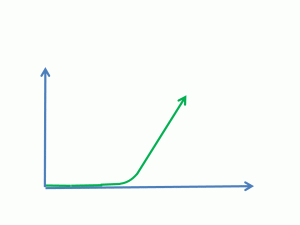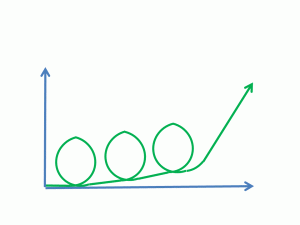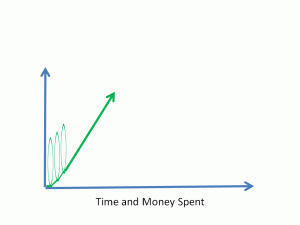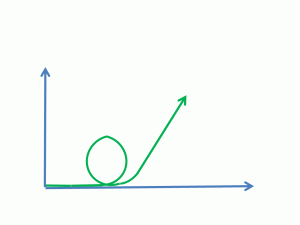Note: This post is a “more serious” continuation from my parody about the startup journey, 140 Simple Steps to Startup Success
It was the height of the dotcom boom, and I found myself sitting down for an informal meeting with the one and only Clayton Christensen from Harvard Business School. We had hired one of his former students into NetMind, a startup I co-founded. The distinguished Dr. Christensen was in Silicon Valley after publishing “The Innovators Dilemma” and wanted to hear more about our startup journey.
In that meeting Professor Christensen shared a recent insight about startups – a secret to startup success – based on the companies he had seen. As you might imagine, he had my attention. The secrets to startup success are vigorously debated in Silicon Valley. In fact, just sitting down in any Starbucks around here will likely place you in the middle of what often sounds like a sports radio call-in show about startups. You can’t help but overhear “Joe from Palo Alto” ranting like an armchair quarterback about why his startup gig is struggling.
The more informed debates about startup success tend to focus on three factors – product vs market vs team. And since I was pretty familiar with these discussions, I was thinking that just this once I might already know what Dr. Christensen was going to say. Instead, as usual, he said something far more interesting. His insight was that the startups that succeed are simply those that have enough money leftover to try their second idea…….
A Different Growth Model
This was a bit jarring for a first time entrepreneur who was still paddling hard in the murky soup of a first idea. We had taken a sizable venture round, on the premise that our idea, which had a lot of traction with non-paying customers, would soon explode into world domination. In fact, we had even come up with a clever and unique graph to show our trajectory. It looked like this:
 Unfortunately, as you perhaps might recall about the dotcom bubble, there were – in fact – just a few other startups that also predicted this same trajectory. Thankfully, we’re all much smarter now and we’ll never do that again……right?…….
Unfortunately, as you perhaps might recall about the dotcom bubble, there were – in fact – just a few other startups that also predicted this same trajectory. Thankfully, we’re all much smarter now and we’ll never do that again……right?…….
The key point Clayton Christensen was making is that successful real startups don’t actually follow that trajectory. He was saying a real startup trajectory might look something more like this:
Real startups that succeed go through a loop first. If you have ever ridden a roller coaster, you know how a loop feels. It spins you around and induces a temporary loss of direction. Which means for startups, this should be a normal and expected feeling. The big trick is to survive the spin cycle.
The Truth About Successful Startups
The idea that a successful startup most often fails before it succeeds is becoming quite popular. But the concept has been alive in the DNA of Silicon Valley for quite awhile. Silicon Valley is really one of the only environments in the world where failure is actually treated like a good thing – but only if you learn from it and keep going.
Because the truth is that Professor Christensen’s initial observation was only half-right. The honest stories of startup success actually get more interesting. Most entrepreneurs will tell you that idea number two also failed. If you talk to the Twitter co-founders, they will tell you it was a long road to their “overnight” success. For most successful startups, the real curve, actually looks a lot more like this:
 As if one loop wasn’t enough…… Successful entrepreneurship requires persistence and maybe a big box of Dramamine.
As if one loop wasn’t enough…… Successful entrepreneurship requires persistence and maybe a big box of Dramamine.
The Real Startup Success Secret
What is the Real Secret of Startup Success? Clayton Christensen was really close. It starts with having the persistence and resources to continue iterating. There is, however, an important detail – you can’t iterate wildly without context or direction. Buckshot doesn’t actually work for startups. But iteration does. Did you notice in the above graph how each successive loop is a little bit higher than the last? That slightly upward ramp is really important. It means you are learning.
The real secret is to build on what you learned in the last failure.
Which means if you want to succeed, you have to start your journey with a clear understanding of the critical assumptions in your business, and design in the ability to clearly know which of those assumptions are actually wrong. This is very different from throwing any new idea against the wall and seeing what sticks. An iteration based on this knowledge is called “a pivot” by the Lean Startup community. I got to have dinner with Dave Binetti ,Founder/CEO of Votizen one night and he explains pivots way better than I do.
How to Use the Real Secret
But wait a second. If we know the Real Secret to Startup Success, than why is the failure rate of startups so high? Ah, if only it were so simple. I’ll get into more details (with some great ways to avoid common problems) in ensuing posts. However, our loopy trajectory model exposes two huge reasons:
1) The amount of persistence required to get through the loops is pretty high. It takes a special kind of person with a special level of passion. Even then, each loop is full of drama and emotional issues that can derail a team despite their commitment (which is a topic for other posts).
2) Having enough resources to get through the loops is hard. “Resources” usually means money. It also means time. The traditional method for getting through each loop is to build something that might work, get it out to customers and see what happens. That always takes money (unless you are still living at home and can do it all yourself), and time (unless you happen to be traveling at the speed of light.)
So the model tells us your risky startup is actually a sure thing if you can satisfy three simple conditions:
a) You are unusually persistent by nature, and
b) Your parents will let you have your old bedroom back (for free), and
c) You can make your parents house travel at the speed of light (while you’re inside working away.)
We can all see the obvious problem here ……no pizza delivery car can travel at the speed of light, and let’s face it, you can’t do a startup without pizza. So if you can’t do those three things, fear not, there is a support group for you called “the rest of us.”
How Mere Mortals Use the Real Secret
But what if, (just run with me for a second here)……what if mere mortals working in earth time could accelerate through those loops with minimal time and money? Imagine those dazzling graphs shown above with the X axis representing “Time and Money” (which would be a good thing to imagine because that’s what the axis is.) What if you could somehow compress the graph and do this….. In this scenario, we still accept the journey through the loops as an immutable law of physics for successful startups. Except this time, we magically sprint through those loops, and do it in a way that still picks up the same wisdom and insights that might come from spending more time and more money. To the outside world, it looks like a lucky overnight success, but those of us who were actually on the ride would know we indeed paid our dues and we look smart for a reason. Our success is not about luck.
In this scenario, we still accept the journey through the loops as an immutable law of physics for successful startups. Except this time, we magically sprint through those loops, and do it in a way that still picks up the same wisdom and insights that might come from spending more time and more money. To the outside world, it looks like a lucky overnight success, but those of us who were actually on the ride would know we indeed paid our dues and we look smart for a reason. Our success is not about luck.
How do we do that? To travel fast, you have to travel lightly. Everyone who has seen or ridden a motorcycle knows it is far more quick and agile than a car. Yet a motorcycle has a much smaller engine than a car. It gets its speed from traveling lightly. Startups often make the mistake of trying to get the through the loops in a car, or a jeep, or an SUV, or if you were WebVan, a big-ass semi.
What we need are efficient, smart ways to accelerate (that means getting the job done without spending a lot of money or time). We have to accelerate like a rocket or an electron trying to achieve escape velocity. The Lean Startup movement and incubators like Y Combinator preach speed – they are all about being fast through the loops; however, with each post, I plan to walk through specific new stuff you can do that no one else is talking about and will help you accelerate and iterate quickly. (Thus the name…….Smart Fast Startup……)
The first huge accelerator comes from a new concept called Monetizable Pain. It’s something I wish I knew back in those dotcom days during my first startup. Check it out in the next post coming up.

Other ways to connect